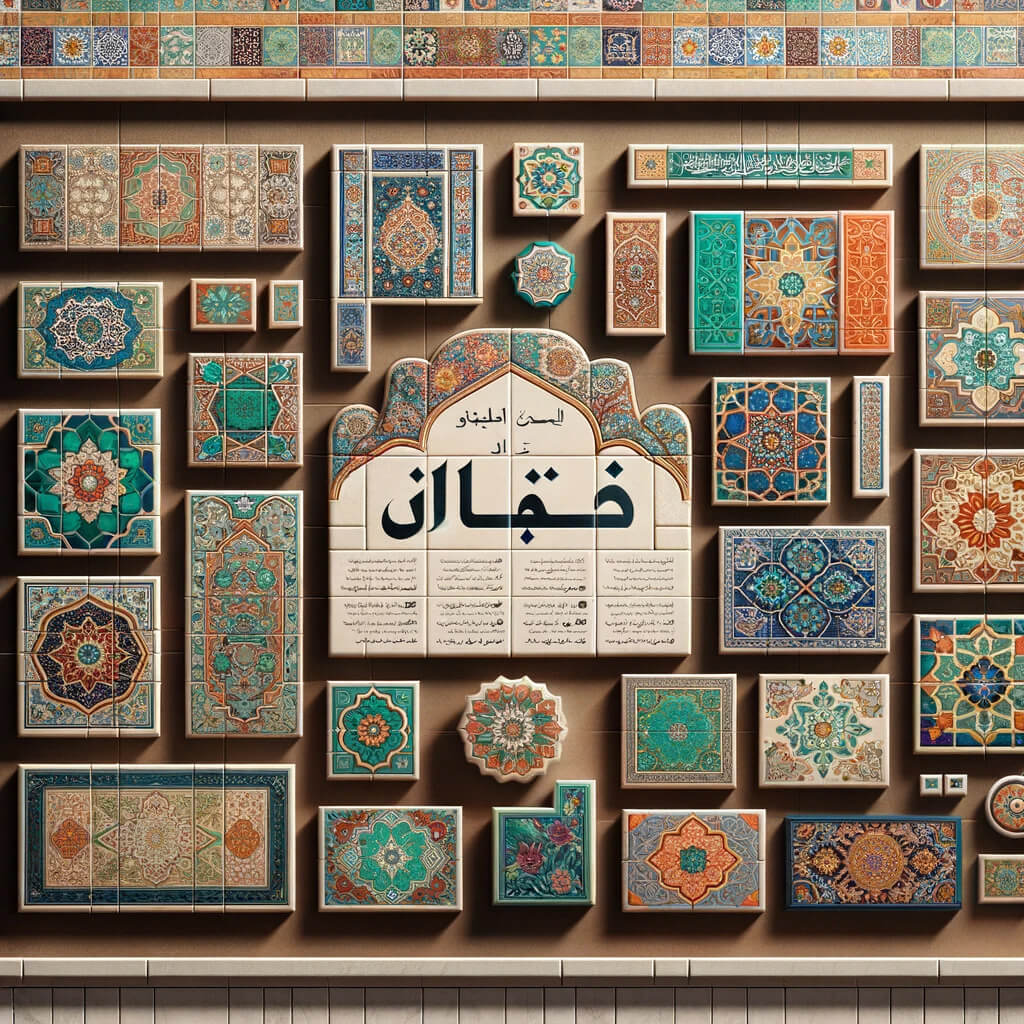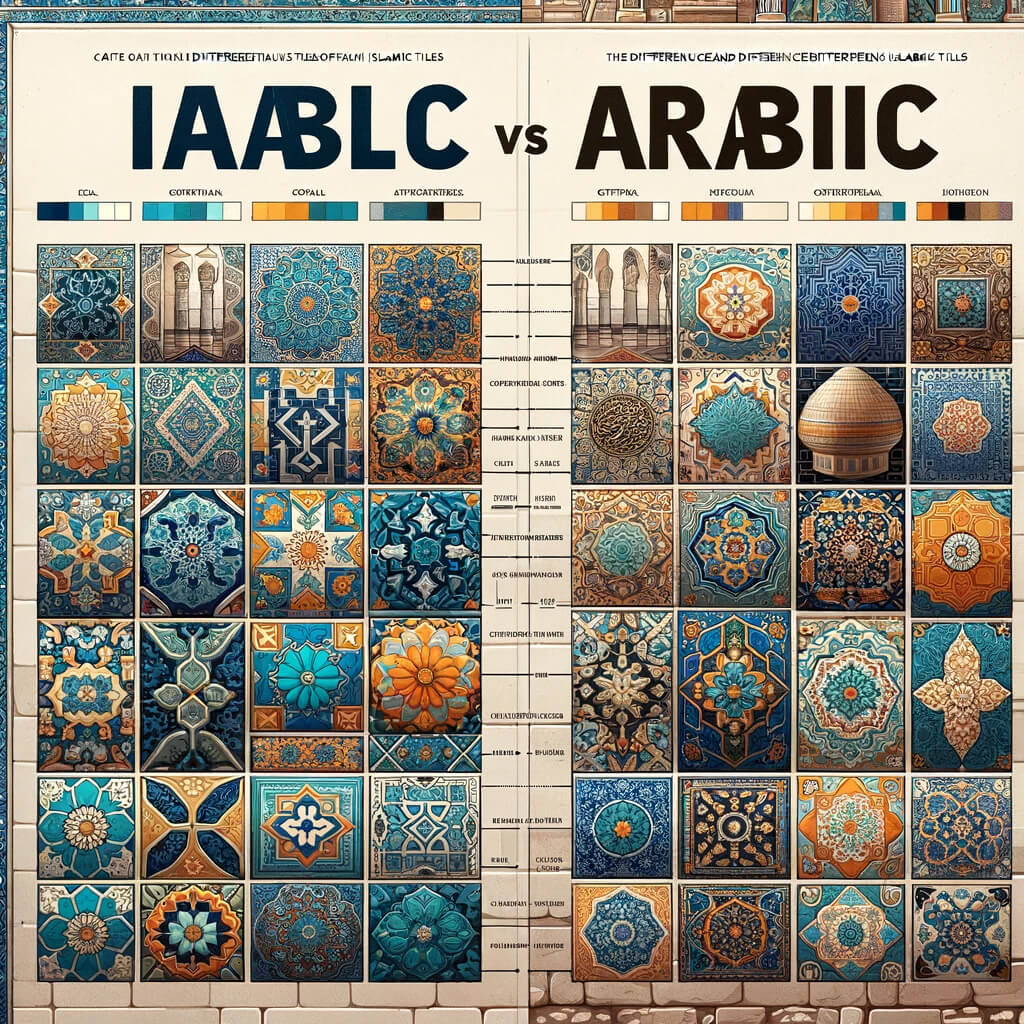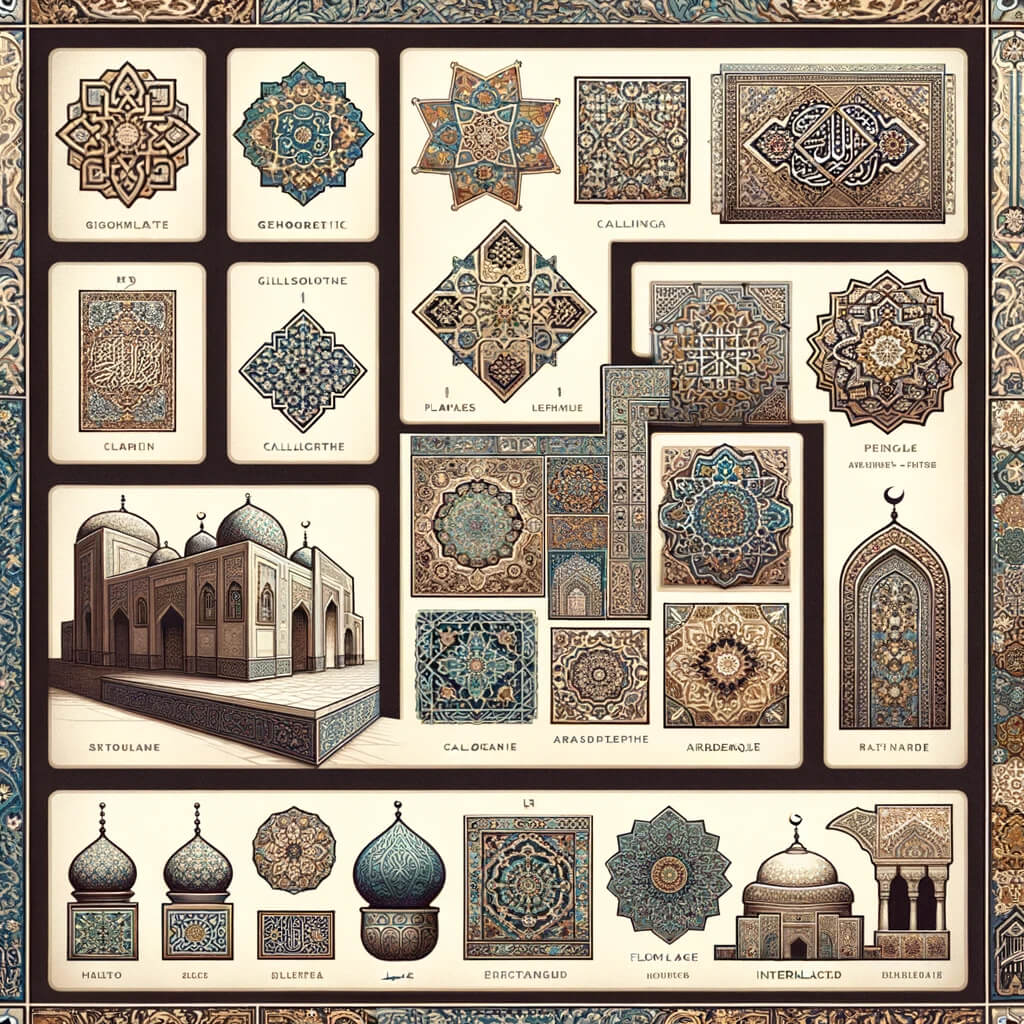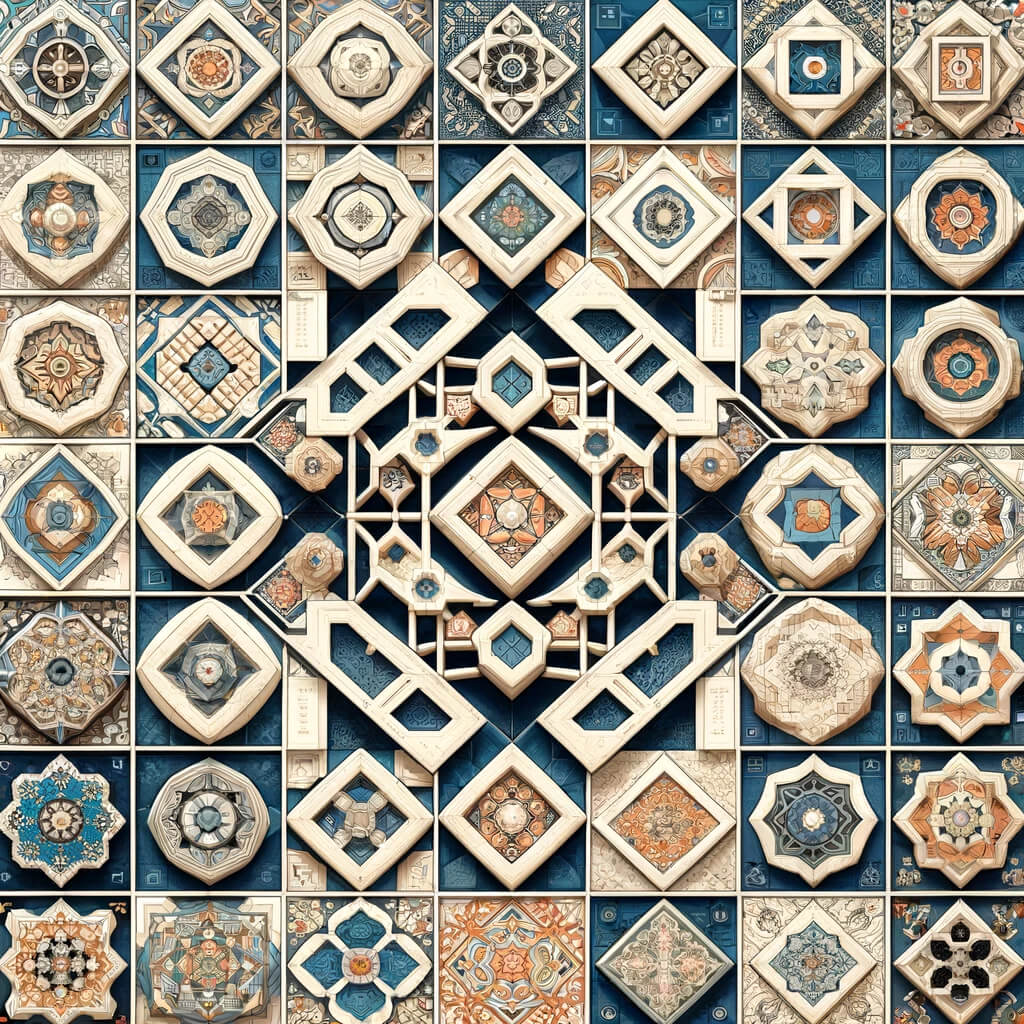Capture the essence of architectural beauty with Arabic tiles, an art form that marries centuries-old traditions with modern design sensibilities. From the vibrant colors and intricate geometric patterns to the profound cultural and religious significance they embody, Arabic tiles offer an unparalleled aesthetic that transforms any space into a masterpiece of visual storytelling.
Dive into our comprehensive guide to explore the history, craftsmanship, and timeless appeal of Arabic tiles, and discover how you can incorporate this exquisite art form into your own designs.
Table of Contents
What are Arabic tiles?
Arabic tiles, known for their intricate designs and vibrant colors, are a significant aspect of Islamic art and architecture. These decorative tiles have been used for centuries to adorn the walls, floors, and ceilings of buildings, ranging from mosques and palaces to homes. The beauty of Arabic tiles lies in their detailed geometric patterns, calligraphy, and floral motifs, which are not only aesthetically pleasing but also carry cultural and religious significance.
The use of tiles in Islamic art is partly due to the Islamic aniconism, which discourages the representation of living beings in religious contexts. This led artists and craftsmen to develop a unique style that emphasizes non-figurative art, resulting in the intricate geometric and abstract designs seen in Arabic tiles. These designs often incorporate mathematical precision and are believed to reflect the infinite nature of the universe, symbolizing the unity and order of the Islamic faith.
Arabic tiles are typically made from ceramic, a material chosen for its durability and ability to hold vibrant glazes. The process of making these tiles can be complex, involving the careful cutting of the tiles into specific shapes before they are painted and glazed. Historically, the colors used in these tiles were limited to a few bold choices, such as blue, green, yellow, and white, due to the limitations of the glazes available at the time. However, these colors have come to define the classic Arabic tile palette.
The art of Arabic tiling has influenced various cultures around the world, particularly in Spain and Portugal, where the Moorish influence introduced the use of azulejos (painted ceramic tiles) in the Iberian Peninsula. Today, Arabic tiles continue to be appreciated for their beauty and craftsmanship, and their designs can be found in various forms of modern decor, representing a bridge between traditional Islamic art and contemporary design.

What are the differences between Islamic tiles and Arabic tiles?
The terms “Islamic tiles” and “Arabic tiles” are often used interchangeably, but they can denote subtle differences in context, geography, and cultural influences. Here’s a breakdown of the distinctions:
Geographic and Cultural Context
- Arabic Tiles: This term typically refers to tiles that originate from Arabic-speaking countries within the Middle East and North Africa. Arabic tiles are strongly influenced by the Arabic culture, language, and traditions. The designs might feature Arabic calligraphy, geometric patterns, and motifs inspired by the region’s flora and fauna.
- Islamic Tiles: Islamic tiles refer more broadly to tiles produced within the Islamic world, which encompasses a wide range of countries and cultures beyond the Arabic-speaking ones. This includes regions in Central Asia, South Asia, Southeast Asia, the Iberian Peninsula (due to historical Islamic presence), and parts of sub-Saharan Africa. Islamic tiles thus reflect a diverse range of styles, techniques, and influences, including Persian, Ottoman, Moorish, and Mughal, among others.
Design and Artistic Influences
- Arabic Tiles: Arabic tiles might focus more on specific styles that have been historically prevalent in Arab lands, such as those seen in Moorish architecture or the Maghreb. The use of Arabic calligraphy and specific regional motifs would be more pronounced.
- Islamic Tiles: Islamic tiles encompass a broader spectrum of designs, including the intricate floral and vegetal motifs of Persian tiles, the Iznik tiles of the Ottoman Empire with their distinctive reds and blues, and the complex tileworks of Indian Mughal architecture. The diversity in Islamic tiles reflects the vastness and cultural richness of the Islamic world.
Function and Symbolism
- Both Arabic and Islamic tiles serve not only as decorative elements but also have religious and cultural symbolism. The geometric patterns symbolize the infinite nature of the universe, reflecting a search for spiritual understanding through mathematical and geometric abstraction. Floral and vegetal motifs represent the paradise garden, a recurring theme in Islamic art symbolizing divine beauty and the promise of paradise.
Materials and Techniques
- The materials and techniques used in both Arabic and Islamic tiles can be similar, including the use of ceramic, the application of intricate glazes, and the creation of patterns through techniques like cuerda seca (dry cord) and lustreware. However, regional variations in materials and techniques can lead to differences in appearance and texture between tiles from different parts of the Islamic world.
In summary, while the terms might be used interchangeably in some contexts, “Islamic tiles” refers to a broader category encompassing the entire Islamic world, including its diverse cultures and artistic traditions. “Arabic tiles” might be used more specifically to refer to tiles from Arabic-speaking regions, with a stronger emphasis on Arabic cultural and linguistic influences.

Arabic tile patterns
Arabic tile patterns are renowned for their complexity, beauty, and the use of geometry to create intricate designs that often carry symbolic meaning. These patterns can be broadly categorized into a few main types, each with its own unique characteristics and aesthetic appeal. Here’s an overview of some of the most common types of patterns found in Arabic tiles:
1. Geometric Patterns
Geometric patterns are perhaps the most iconic and widely recognized feature of Arabic tile art. These patterns are made up of basic geometric shapes like squares, triangles, and hexagons, arranged in a way that they form complex, repeating designs. The precision and mathematical harmony in these patterns reflect the Islamic view of the universe as an orderly, interconnected creation.
2. Calligraphic Patterns
Calligraphy, the art of beautiful handwriting, is another important element in Arabic tile designs. Arabic calligraphy can include verses from the Quran, poetry, or proverbs, rendered in highly stylized script. These calligraphic designs are not only decorative but also carry profound spiritual and philosophical meanings.
3. Floral and Arabesque Patterns
Floral patterns, often stylized and abstracted, are commonly used in Arabic tiles. These can include simple representations of flowers and plants or more complex arabesque designs that interweave stems, leaves, and blossoms into flowing, continuous patterns. Arabesques symbolize the transcendent and infinite nature of creation, echoing the unity and omnipresence of the divine.
4. Interlacing and Knotwork
Interlacing patterns and knotwork involve the crossing of lines and bands in a way that they appear to weave over and under each other. These designs can be purely geometric or may incorporate floral and arabesque motifs. The interlaced patterns symbolize the interconnectedness of all things and the eternal cycle of life.
5. Star and Cross Patterns
Star and cross patterns are a subset of geometric designs that feature prominently in Arabic tilework. These patterns typically consist of eight-pointed stars interspersed with crosses or other geometric shapes, creating a rich tapestry of visual effects. The star motif is often used to represent the heavens and the universe.
Color in Arabic Tile Patterns
The colors used in Arabic tile patterns also hold significance. Blue, green, turquoise, and cobalt are prevalent, symbolizing the heavens and the waters, elements that are highly esteemed in the desert landscapes of many Arabic-speaking countries. Earthy tones like ochre and terracotta are also common, grounding the designs and reflecting the natural environment.
Arabic tile patterns are a testament to the skill, creativity, and spiritual depth of their creators. They continue to inspire artists, designers, and architects around the world with their timeless beauty and intricate symbolism.

Are Arabic tile patterns Geometric?
Yes, many Arabic tile patterns are geometric. Geometric patterns are a fundamental and highly characteristic element of Arabic tile art, embodying the Islamic world’s love for symmetry, mathematical precision, and abstract beauty. These patterns are created using simple shapes like squares, circles, triangles, and hexagons, which are meticulously arranged to form intricate, repeating designs that can be infinitely extended.
The geometric patterns in Arabic tiles are not just decorative; they carry deep symbolic meanings. They reflect the Islamic cultural emphasis on aniconism (the avoidance of depicting living beings) and are seen as a way to represent the infinite, unending nature of the universe, symbolizing the unity, order, and complexity of creation as understood in Islamic theology.
The creation of these patterns often involves complex mathematical principles, including symmetry, tessellation (covering a surface with a pattern of flat shapes so that there are no overlaps or gaps), and the use of algorithms to create repetitive designs that suggest infinity. This mathematical basis aligns with the Islamic view of mathematics as a universal language and a reflection of the divine order of the universe.
In addition to their aesthetic appeal and symbolic depth, the geometric patterns in Arabic tilework also demonstrate the remarkable technical skills of the artisans who create them. The precision required to design and execute these patterns on tiles, ensuring that they align perfectly when installed, is a testament to centuries of accumulated knowledge and practice in the art of tile-making.
Therefore, geometric patterns are not only a distinctive feature of Arabic tile art but also a profound expression of cultural values and artistic excellence within the broader context of Islamic art and architecture.

How to draw Geometric Arabic tile patterns with Grasshopper?
Grasshopper, a visual programming plugin for Rhinoceros 3D (Rhino), is a powerful tool for creating complex patterns and geometries, including geometric Arabic tile patterns. It allows designers and architects to generate intricate designs through a flowchart-like interface that manipulates inputs and geometry. Here’s a simplified overview of how you might approach drawing geometric Arabic tile patterns using Grasshopper:
1. Start with Basic Shapes
- Initialize Your Canvas: Begin by setting up a basic shape that will form the foundation of your pattern. This could be a circle, square, hexagon, or any polygon. In Grasshopper, you can create these shapes using the corresponding components.
- Define Parameters: Set up sliders or other input methods to easily adjust the size, radius, or number of sides of your basic shape. This allows for flexibility and experimentation in the early stages of your design.
2. Create a Grid
- Arrange Shapes: Use the “Array” or “Grid” components to replicate your basic shape across a defined area. This step is crucial for creating patterns that extend and tessellate across surfaces.
- Adjust Grid Parameters: Implement sliders to control the spacing and distribution of shapes within the grid, allowing for dynamic adjustments to the pattern density and layout.
3. Apply Transformations
- Rotate and Scale: Utilize transformation components to rotate, scale, or mirror your shapes within the grid. This can introduce variation and complexity into your pattern.
- Explore Symmetry: Experiment with different symmetries and transformations to achieve the desired aesthetic. Symmetry plays a significant role in Arabic geometric patterns, embodying balance and harmony.
4. Tessellation and Interlocking
- Tessellate Shapes: To create more complex interlocking patterns, explore tessellation components that allow shapes to fit together without gaps or overlaps. This may involve custom scripting within Grasshopper if the desired effect goes beyond the capabilities of standard components.
- Fine-Tune Connections: Ensure that the edges and vertices of your shapes align precisely, creating a seamless pattern. This might require adjusting the original shapes or their placement within the grid.
5. Add Detail and Layering
- Incorporate Detail: Once you have the basic pattern layout, you can start adding details by subdividing shapes or adding smaller elements within or around the primary shapes.
- Layer Patterns: Consider overlaying multiple patterns with different scales or orientations to create depth and complexity. Adjusting the opacity or color of layers can add visual interest and highlight the pattern’s hierarchy.
6. Final Adjustments and Export
- Refine Your Design: Use the feedback from the Grasshopper and Rhino viewport to refine your design. Adjust parameters as needed to perfect the pattern.
- Export for Fabrication: Once satisfied with the design, you can prepare it for fabrication or presentation. Grasshopper offers various options for exporting geometry to other formats or directly to fabrication tools.
Learning to use Grasshopper effectively, especially for complex designs like Arabic tile patterns, requires practice and experimentation. Engaging with the Grasshopper community, tutorials, and example projects can provide valuable insights and techniques for advancing your skills in computational design and pattern making.
Conclusion
Arabic tiles encapsulate the exquisite craftsmanship and profound artistic expressions rooted in Islamic and Arabic cultures, serving as a testament to the rich heritage and enduring appeal of geometric and abstract designs in art.
Through the exploration of their origins, cultural significance, and diversity in patterns and techniques, we gain insight into the intricate world of these decorative elements that have adorned architectural marvels for centuries.
The ability to create and interpret these patterns, even with modern tools like Grasshopper, underscores the timeless nature of Arabic tile art, bridging traditional aesthetics with contemporary design and technology.




